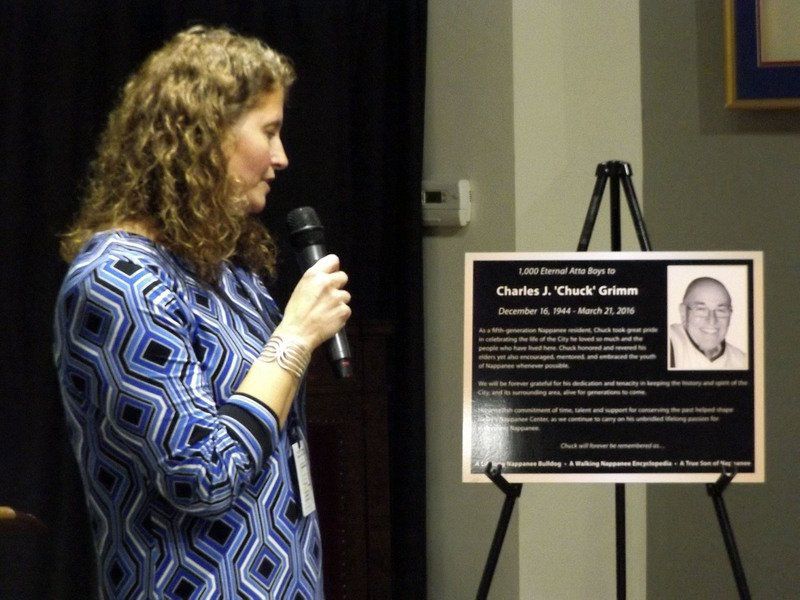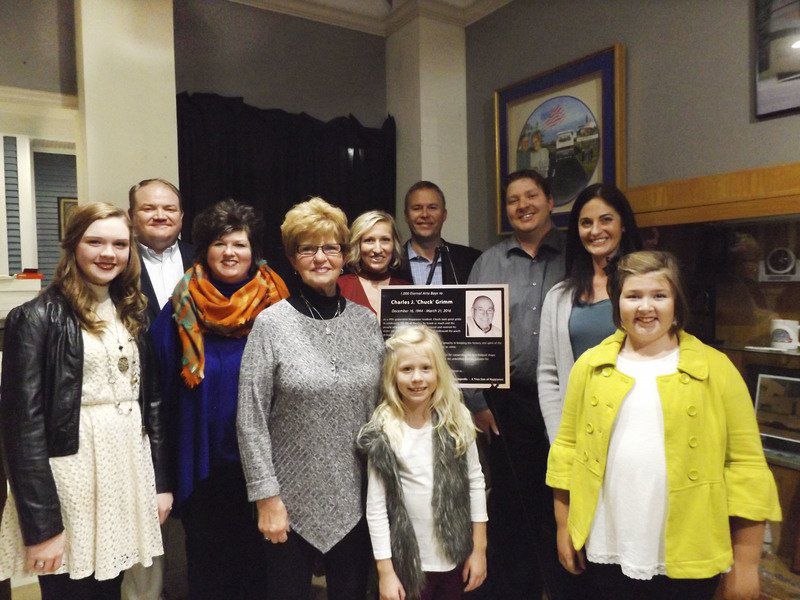Nappanee Center's anniversary celebration includes tribute to historian
Nappanee Center celebration includes tribute to historian
NAPPANEE — A large crowd showed up at the Nappanee Center Monday night to celebrate the 10th anniversary of the center, which houses the historical collection, the chamber of commerce and redevelopment offices and to honor one of the men who was instrumental in making it happen — Chuck Grimm.
The 10th Anniversary Committee, consisting of Martha Owen, heritage collection manager; Lana McCoy, assistant library director; Kayci Detweiler, communications specialist; and Kim Young, public service specialist, came up with several ways to honor Grimm, who died in March. A presentation was made at the end of the program.
The Nappanee Center was a collaborative effort of the city of Nappanee, the Redevelopment Commission, Nappanee Library and Nappanee Historic Preservation.
Library Director Lissa Krull provided the background of the center, stating that those entities met in April 2005 to discuss the collaboration. Krull said the Evelyn Lehman Culp Heritage Collection had outgrown its space in the library and there were collections that couldn’t be displayed. The Chamber of Commerce was looking for a new home. In October 2006, the city purchased the building and by the end of the month the Historic Preservation Committee was meeting at the center.
Krull said Chuck Grimm was passionate about preserving the heritage collection and finding a permanent home for it so both locals and visitors could enjoy it.
Krull offered special thanks to former Mayor Larry Thompson, former Redevelopment Director Larry Andrews and former Library Director Linda Yoder for their work to make the center happen. She said two people in particular are responsible for making the collection what it is today — Evelyn Lehman Culp and Chuck Grimm.
Former librarian and library board member Evelyn Lehman Culp started the drive for a heritage collection to have it in time for the city’s centennial celebration and the first time the collection was displayed was in 1971. In 1987, the first historic preservation commission was formed and in 1989 the heritage collection was renamed the Evelyn Lehman Culp heritage collection.
“Thirty-five years after that first display, we were lucky enough to have Chuck Grimm step up to keep Nappanee’s history front and center,” Krull said.
Former Mayor Larry Thompson recalled the first time he saw Chuck’s collection of Nappanee memorabilia. “I could not believe what I witnessed in your basement,” he told Carol, Chuck’s widow. “How organized and how extensive — I was blown away.”
Thompson said he thought, “If Dick Pletcher can build a furniture store around the oldest house in Nappanee we could make this happen.”
The challenge he was given by city officials was to make it happen without using tax dollars. Several key members helped to make it happen, including Virgil Miller of Newmar, which is why there’s a collection about Newmar in the museum.
Thompson said, “In my 20 years as mayor I had two special friends who helped me think outside the box — one was Chuck Grimm. If Chuck didn’t like it right away I knew public opinion wouldn’t.”
He said Grimm and John Leavitt acted as his barometer at times. “From the time we started on this building our friendship became deeper. It means a lot to me that we are honoring him in this way. No one could’ve believed that we wouldn’t have Chuck here celebrating the 10th anniversary.
“He loved this city more than anyone. I really miss the guy, but this is a place you can come and be close to Grandpa,” he told Chuck’s granddaughters.
Former Library Director Linda Yoder said it was an honor to be asked back and said being there was a reminder to her of what drive and passion could accomplish. She recalled meetings with Larry Thompson, Larry Andrews and Chuck Grimm and said, “We talked a lot about community pride, preservation and how that tied into the economy and tourism.”
She spoke of Evelyn Lehman Culp and said she became known for her colorful platform shoes and even though her feet were physically small they’d be hard shoes to fill.
“Chuck’s shoes are different — bigger, not as colorful, but they represent a dogged determination to persevere. He’s taken it even further than Evelyn may have imagined.”
Krull cited the 4,700 hours donated by Chuck and his wife Carol. Chuck worked 25 to 30 hours a week, continuously in pursuit of new items for the collection that now numbers more than 3,500 items.
“Chuck took great pride in preserving history whether it was listening to family stories in a barn or giving tours of the center to kids,” she said.
Grimm recently coordinated “Our Town,” a Chautauqua-type presentation. He worked with high school students to document the tours he gave; worked with the police to get the first jail cell, used from 1890 to 1972; cleaned up and part of the collection and designed and built mannequins to display the military uniforms. Grimm was named the 2011 History Educator of the Year by his peers on the historical preservation commission.
John Leavitt, representing the library board of trustees, started his speech with an observation that humored him. He said after listening to everyone speak it occurred to him, “If you had to picture two more polar opposites both in stature and demeanor it would be Evelyn and Chuck,” he laughed. “Evelyn asked for items for the collection, Chuck demanded them.”
“One word that kept coming up in regards to Chuck was passionate. It oozed out of him, particularly when it comes to Nappanee,” Leavitt said. “Chuck exemplified the simple everyday things people do. Nobody bled Bulldog Blue more than Chuck, but when it came time to support the Panthers he made the switch.”
Leavitt said so many of the iconic things in the collection are due to Chuck’s work — the infamous Foo car, the Max Gwin cartoonist collection, the Air Force One collection and more. Leavitt said the mannequins for the military uniforms that Grimm designed and built are now the prototype for the Indiana Historical Society. He told the visitors before they left to look around and see Chuck’s fingerprints all over.
“And if you listen carefully you just might hear his voice encouraging us to love kids.”
Commemoratives and Proclamations
Krull said the 10th anniversary committee had a hard time deciding on one way to honor Chuck so they picked three. Because Chuck designed historical placemats for the area restaurants to use at one time, they redesigned the placemats in his honor and they will be placed in restaurants.
Because he loved to give visitors a piece of Nappanee to take home, they designed note cards and asked them to pass them out to friends and family.
Lastly, as a lasting and permanent tribute, they created a plaque that read in part, “1,000 eternal attaboys” for Grimm, a fifth-generation resident.
“We will be forever grateful for his dedication and tenacity in keeping the history and spirit for the city and surrounding areas alive for generations to come,” Krull said.

Mayor Phil Jenkins shared how he sat down with Chuck and Dick Pletcher to get his Nappanee historical facts straight shortly after taking office. Jenkins said since he grew up in Nappanee he shared Chuck’s passion and promised that under his administration he’d continue to support and grow the Nappanee Center.
Jenkins read two proclamations: one for the anniversary of the center and one for Chuck Grimm, declaring Nov. 14 to be Nappanee Center Day and Chuck Grimm Day.
The Nappanee Historic Preservation Commission will sorely miss our leader. We carry on his legacy and love for preserving the history of our community.
 Living Gospel Church – formerly the First Brethren Church According to “They Called it Nappanee,” the beginning of the First Brethren Church started with two lots purchased on West Walnut Street where a sawmill had previously stood, and by February 1897 a church building was dedicated. A newspaper article of March 1897 stated that it was "made up of people of thrift and economy." At that time the church was served by a circuit pastor. Through the years extensive remodeling programs took place. Unfortunately, the original First Brethren Church burned in a fire in February of 1948, destroying the original building and its contents, landing a devastating blow to the congregation. Joseph Harrison Hossler, a faithful congregant of First Brethren and Chicagotrained cartoonist, was asked to design a new church. He had no architectural experience, but according to his contemporaries, through the help of God and his talent, he designed a beautiful building that stands today as a monument to his faith.
Living Gospel Church – formerly the First Brethren Church According to “They Called it Nappanee,” the beginning of the First Brethren Church started with two lots purchased on West Walnut Street where a sawmill had previously stood, and by February 1897 a church building was dedicated. A newspaper article of March 1897 stated that it was "made up of people of thrift and economy." At that time the church was served by a circuit pastor. Through the years extensive remodeling programs took place. Unfortunately, the original First Brethren Church burned in a fire in February of 1948, destroying the original building and its contents, landing a devastating blow to the congregation. Joseph Harrison Hossler, a faithful congregant of First Brethren and Chicagotrained cartoonist, was asked to design a new church. He had no architectural experience, but according to his contemporaries, through the help of God and his talent, he designed a beautiful building that stands today as a monument to his faith.


















